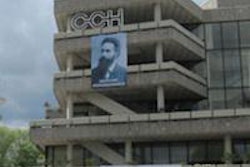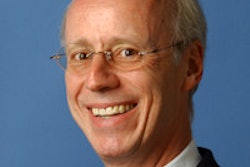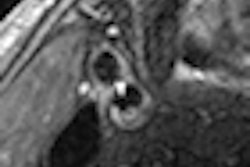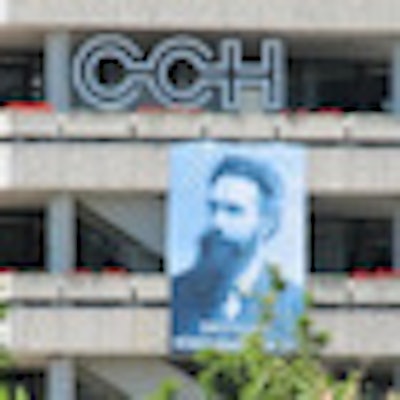
Two of AuntMinnieEurope's new editorial advisers attended the German Radiological Society's annual meeting, the DRK, in Hamburg. They describe the program highlights, and present their views on the conference, which attracted more than 7,500 delegates.
Dr. Matthias Dietzel, assistant professor of radiology, Friedrich-Schiller-University, Jena:
For the second time in its 93-year history, the world's oldest meeting dedicated to medical imaging took place in Hamburg from 16 to 20 May. This great city with its unique charm, architecture and urbanism was again a perfect location for the DRK. Returning back to the Congress Centre Hamburg (CCH), the host of this excellent meeting, was already like coming home after a long trip. Everything remained at the same location and could be found easily. Also a well-known tradition continued and the session rooms were named after famous pioneers, including Donner, Eberlein, and of course Roentgen himself.
 Main entrance to the Congress Centre Hamburg (CCH), the venue of the DRK. In the back is the Hamburg TV Tower. The CCH is located in downtown Hamburg close to the railway station "Dammtor" and the recreational park "Planten un Blomen." Image courtesy of Dr. Matthias Dietzel.
Main entrance to the Congress Centre Hamburg (CCH), the venue of the DRK. In the back is the Hamburg TV Tower. The CCH is located in downtown Hamburg close to the railway station "Dammtor" and the recreational park "Planten un Blomen." Image courtesy of Dr. Matthias Dietzel.Dr. Thomas Helmberger, the congress president, chose a motto for the meeting and continued this still new tradition: "Gegensätze verbinden" (linking opposites). Quoting the great Danish philosopher, theologian, and author Kierkegaard, this motto seems to be a little provocative at the first glance. Certainly it sounds a little bit paradoxical, the more it is true: Our profession has expanded so rapidly over the last century and evolved so fast, that radiology now covers an immense area of imaging modalities, technical possibilities, and interventional procedures.
Actually this variety is sometimes challenging to combine under one roof and requires visionary leadership and an interdisciplinary platform. Accordingly, Helmberger invited numerous prominent colleagues including cardiologists, vascular surgeons, and gastroenterologists to attend the meeting. Together with expert radiologists they discussed hot topics of medical imaging, brand new innovations and -- most of all -- optimized patient care within the format "DRG meets ... ."
To link all facets of our specialty, a broad spectrum of educational and scientific sessions were prepared by the program committee. Many well-known formats were met again, including classical scientific sessions (fresh data from academic radiology presented in short presentations) and refresher courses (educational lectures by prominent radiologists presenting a broad range of basic knowledge in radiology). Although the highlights within these categories are too many to be presented here, the talks by Dr. Jürgen Freyschmidt certainly need to be mentioned: With his excellent rhetoric, subtle humor, inspiring enthusiasm, and legendary knowledge he quizzed the audience on "difficult and apparently difficult diagnoses in skeletal radiology."
According to Freyschmidt, most important for an appropriate diagnosis in musculoskeletal radiology is to see the patient. This is particularly true, as without detailed knowledge on clinical presentation and patient history a good radiological diagnosis is impossible.
Concerning the interpretation of the images, Freyschmidt compared our job to the famous fictional detective Sherlock Holmes: Most important is descriptive observance using a clear terminology (e.g. Lodwick classification, engrams, etc.). This is followed by interpretation of the observance enabling a logical conclusion like in the short stories by Sir Arthur Conan Doyle.
Besides the classical refresher courses, the most popular format within the educational program was again the "FFF" ("Fit für den Facharzt," "Fit for the board certification examination"). The latter is intended for senior residents preparing for this challenging examination. FFF is an interactive, case-based course and provides a rapid review of general radiology. Thanks to the TED-system of the CCH, every participant was able to individually test his knowledge.
Investing in youth
Yet, the congress offered not only a wide variety of educational talks but served as a platform for medical students and young academic radiologists. The DRG (Deutsche Röntgengesellschaft; German Roentgen Society) has launched several projects during the last few years to promote our highly attractive specialty. There is no doubt that radiology is often underrepresented in the curriculum of medical schools. This is why the DRK has launched the project "hellste Köpfe für die Radiologie" (the brightest heads for radiology). It is a unique initiative for medical students to promote our specialty, offering a wide range of services including a home page, Web-based seminars for the preparation of the final exams, and special sessions for students at the congress.
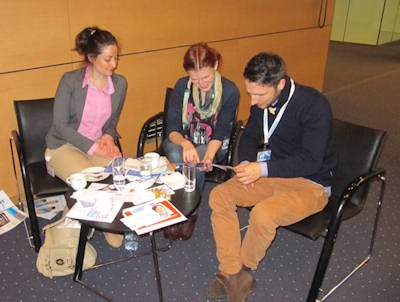 "Where do we go next?" Residents take a break between sessions. The program was packed with countless scientific and educational presentations covering all aspects of general radiology and numerous subspecialties such as pediatric radiology. Image courtesy of Dr. Matthias Dietzel.
"Where do we go next?" Residents take a break between sessions. The program was packed with countless scientific and educational presentations covering all aspects of general radiology and numerous subspecialties such as pediatric radiology. Image courtesy of Dr. Matthias Dietzel.As this program has become highly popular, the community has been growing considerably over the past few years. It was easy to realize the success of this project: Numerous highly motivated medical students attended the meeting and they were met not only at the students lounge and in sessions especially designed for them, but virtually everywhere at the venue.
Furthermore, the investment in the youth focused on residents with special interest in academic radiology: For the fourth time, the German Roentgen Society sponsored the "young investigator award" for junior radiologists. This prize is intended to boost the career of residents with special interest in academic radiology.
Candidates for this prize presented innovative scientific projects within a dedicate session. The jury led by Professor Fabian Kießling from Aachen had the tough job to select the two best speakers presenting the finest and most promising project. Finally they chose Mario Zeller and Katja Hüper for this year's "young investigator award."
Mario Zeller is a young physicist from Würzburg presenting his promising approach enabling a significant reduction of scan time for T2-weighted Turbo Spin Echo Sequences. Dr. Hüper is a resident in general radiology from Hannover with special interest in molecular imaging and preclinical research. She presented an excellent paper on histopathological changes caused by diabetic nephropathy. For this she used a dedicated animal model (rat) and applied diffusion tensor imaging for noninvasive monitoring of the disease. According to her initial results, this technique allows the assessment of characteristic changes within the different stages of diabetic nephropathy due to a reduction of the fractional anisotropy (FA).
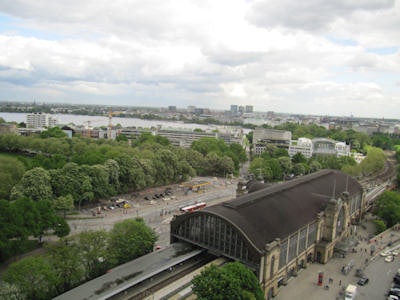 View from the Congress Hotel of the railway station "Dammtor" to downtown Hamburg and the outer Alster (Außenalster), a famous recreational area within the heart of Hamburg, the host city of the DRK. Image courtesy of Dr. Matthias Dietzel.
View from the Congress Hotel of the railway station "Dammtor" to downtown Hamburg and the outer Alster (Außenalster), a famous recreational area within the heart of Hamburg, the host city of the DRK. Image courtesy of Dr. Matthias Dietzel.As in the past years, a wide range of scientific presentations were given during the four congress days. Indeed it was not possible to attend every session. This is why every attendee had to choose his personal selection. Let me therefore highlight just a few presentations:
Dr. Hartmut Burmeister from Lübeck gave a notable talk on the radiological anatomy of the olfactory bulb and olfactory tract. Using high-field MRI (3.0-tesla) and MR Microscopy at 9.0-tesla he was able to prove that substructures of this important paleocortical structures can be imaged accurately. These findings might be of clinical significance because neurodegenerative diseases such as Alzheimer's disease lead to changes of microstructural integrity of the olfactory bulb and olfactory tract. This is why accurate imaging might serve as a surrogate for the evaluation of degenerative processes in this particular area of the paleocortex.
Dr. Tobias Struffert from Erlangen gave an excellent talk on the dynamic quantification of angiographic data for the assessment of hemodynamic effects of flow diverters and intracranial stents. He presented an innovative method to reliably evaluate perfusion parameters using a dedicated, newly developed software. Using this approach Struffert was able to quantitatively assess hemodynamic changes after endovascular repair of intracranial aneurysms in an animal model.
Dr. Shirin Buchbender from Düsseldorf presented initial results on the use of arterial spin labeling to quantify perfusion parameters of human breast tumors. According to her results, this MRI technique allows assessment of tumor perfusion without the use of intravenous contrast agents. This might be of potential clinical significance in patients with chronic renal disease undergoing neoadjuvant chemotherapy, Buchbender concluded her innovative talk.
The research team of Dr. Werner Kaiser from Jena presented new data on various aspects on clinical MR mammography. "Accurate differential diagnosis can sometimes be challenging for less experienced readers using this technique. This is why we developed a simple classification tree and validated its results in a large clinical database," explained Dr. Pascal Baltzer from Jena. According to his results this approach allows accurate classification of breast lesions and the author was able to decrease the number of descriptors necessary for this task to a minimum.
Further innovations included the use of breast MRI as a prognostic biomarker. The team from Jena presented a collaboration project with the working group of Dr. Martin Bogdan from Tübingen addressing the combination of enhancement characteristics of breast MRI and machine learning. This approach allowed risk stratification of disease-related death in patients with primary breast cancer with a high diagnostic accuracy of up to 89.6%. Such prognostic data might be implemented into the radiological report and could even impact the therapeutic approach in the future the authors concluded.
After four days packed with networking, new scientific data, and refreshed knowledge in clinical radiology there is no doubt that 93rd DRK was the continuation of a success story. See you next year!
Additional observations from Dr. Peter Bannas, resident, department of radiology, University Hospital, Hamburg and national delegate of radiology trainees for the DRG (Deutsche Röntgengesellschaft e.V.)
The weather was not as outstanding as last year, but it steadily improved over the four days. Again, Hamburg was a wonderful host and there were more than 7,500 delegates, including 500 students. The motto of the congress was: "Connecting antipodes" (Gegensätze verbinden), which was typified even by the congress president Dr. Hermann Helmberger, originating from Munich, the most southern metropolitan city of Germany -- arranging a congress far north in Hamburg.
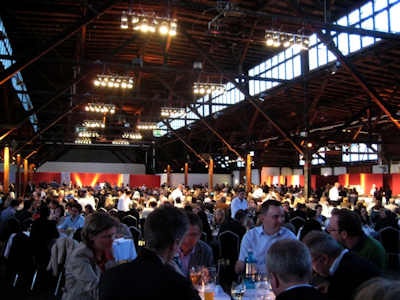 The opening ceremony of the DRK took place at the famous "Schuppen 52" ("Shelter 52"), in the midst of the large containerships and cargo terminals in the Port of Hamburg. Image courtesy of Dr. Peter Bannas.
The opening ceremony of the DRK took place at the famous "Schuppen 52" ("Shelter 52"), in the midst of the large containerships and cargo terminals in the Port of Hamburg. Image courtesy of Dr. Peter Bannas.The motto also reflects the different spectra of radiology and the role of radiology as a cross-sectional specialty in the world of modern medicine. Consequently the congress core areas covered a wide spectrum, ranging from abdominal radiology to cardiovascular radiology, and rheumatologic radiology to pediatric imaging, including interventional radiology. The program was split into two main components: The educational and the scientific program.
The education program was comprised of more than 500 refresher courses and more than 20 poster presentations covered the basic knowledge in radiology. As in the past years, one of the most popular sessions was the FFF-series, which takes advantages of the interactive TED-System, allowing answering the integrated case-based questions.
Among the other excellent sessions of the educational program, one took place for the first time and is worth mentioning: During this FFF-session titled "Forschen & Publizieren" ("Research & Publishing") the three speakers explained strategies for how to write and apply for grants, how to create conclusive illustrations for presentations and publications, and how to improve the scientific writing.
The scientific program consisted of more than 350 scientific presentations during the four congress days, flanked by more than 50 poster presentations. As last year, the sessions covering the field of molecular imaging were highly popular and some of the sessions were overcrowded, so that it was not always possible to get seats. Also the "Young Investigator Award" session was highly popular and offered a broad spectrum of the imaging research fields from young scientists from all kinds of subspecialties.
The 93rd DRK successfully continued the traditions of the previous meetings to bring radiologists together to discuss the latest news in the exiting field of imaging. Altogether, it was a perfect combination of interesting lectures and opportunities for social networking in one of the most beautiful cities in Germany. Hope to meet you next year!




